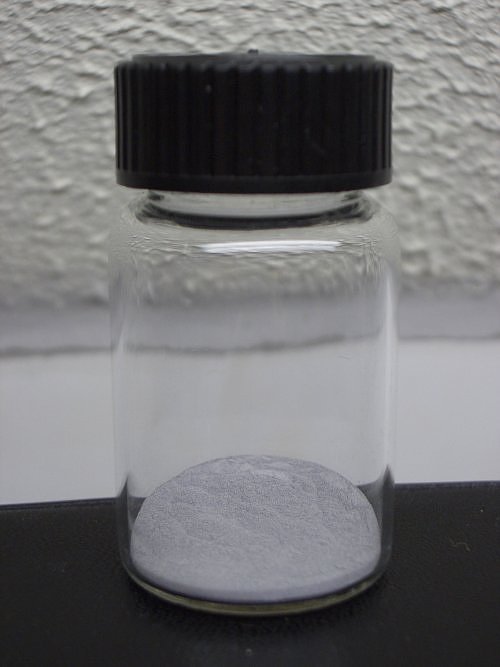


Ruthenium, rhodium, osmium and iridium
 These metals all are shiny silvery or somewhat bluish
(especially osmium is quite bluish) metals in the bulk state. In the powdered
state, they are grey, as shown in the picture at the left, which shows 5 grams
of ruthenium metal.
These metals all are shiny silvery or somewhat bluish
(especially osmium is quite bluish) metals in the bulk state. In the powdered
state, they are grey, as shown in the picture at the left, which shows 5 grams
of ruthenium metal.
The metals osmium and iridium are very dense.
All of these metals are very inert and are among the most noble (= least reactive) of the metals. Together with palladium and platinum these metals sometimes are called the 'platinum metals'.
Ruthenium and osmium, although in the same group as iron, are totally different from iron. These metals can be brought in their +8 group oxidation state, which is not possible for iron. Where iron already is a very strong oxidizer in its +6 oxidation state, ruthenium and osmium even can go to the +8 oxidation state and even then these are not as strongly oxidizing as iron in its +6 oxidation state.
Rhodium and iridium are in the same group as cobalt. These metals also differ very much from cobalt. Like ruthenium and osmium, they are much less reactive than their lighter congener. Rhodium and iridium are most stable in their +3 oxidation state, iridium also is quite stable in its +4 oxidation state, when coordinated to halogens.
For the average home chemist, these metals are not the most interesting, due to their very high prices. All of these metals are available on eBay frequently, but prices are at the order of magnitude of $20 - $100 per gram. Combined with their high density, this means that on a volume-basis these metals are really expensive! I was lucky to obtain the powdered ruthenium for just $8 per gram, usually the prices are much higher.
![]() With some effort
and at high price, one may be capable of obtaining osmium tetroxide, OsO4,
but this is exceedingly dangerous for the home chemist! It is a volatile solid,
which is exceedingly toxic: When the vapor of this compound enters the body, it
is quickly reduced, forming small and sharp crystalline pieces of metallic
osmium, which irritate the surrounding tissue like hell!! Getting vapor of
osmium tetroxide in the eyes leads to extreme pain and in many cases to
blindness! Osmium tetroxide simply should not be present in a home lab.
With some effort
and at high price, one may be capable of obtaining osmium tetroxide, OsO4,
but this is exceedingly dangerous for the home chemist! It is a volatile solid,
which is exceedingly toxic: When the vapor of this compound enters the body, it
is quickly reduced, forming small and sharp crystalline pieces of metallic
osmium, which irritate the surrounding tissue like hell!! Getting vapor of
osmium tetroxide in the eyes leads to extreme pain and in many cases to
blindness! Osmium tetroxide simply should not be present in a home lab.